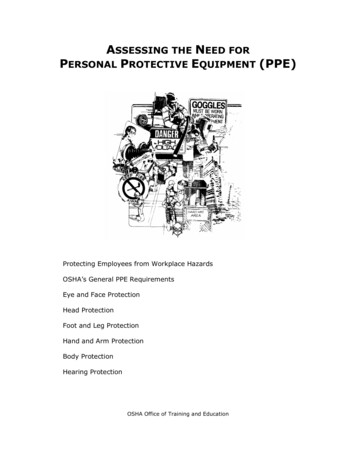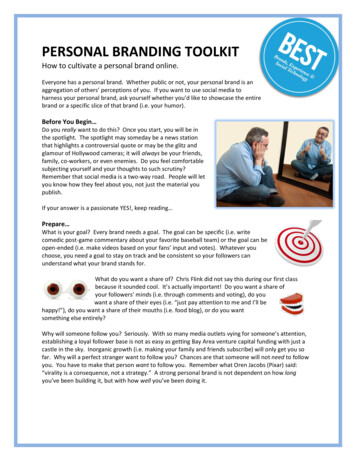
Transcription
ASSESSING THE NEED FORPERSONAL PROTECTIVE EQUIPMENT (PPE)Protecting Employees from Workplace HazardsOSHA’s General PPE RequirementsEye and Face ProtectionHead ProtectionFoot and Leg ProtectionHand and Arm ProtectionBody ProtectionHearing ProtectionOSHA Office of Training and Education
These materials were developed by OSHA’s Office of Training andEducation and are intended to assist employers, workers, and othersas they strive to improve workplace health and safety. While weattempt to thoroughly address specific topics, it is not possible toinclude discussion of everything necessary to ensure a healthy andsafe working environment in a presentation of this nature. Thus, thisinformation must be understood as a tool for addressing workplacehazards, rather than an exhaustive statement of an employer’s legalobligations, which are defined by statute, regulations, and standards.Likewise, to the extent that this information references practices orprocedures that may enhance health or safety, but which are notrequired by a statute, regulation, or standard, it cannot, and does not,create additional legal obligations. Finally, over time, OSHA maymodify rules and interpretations in light of new technology,information, or circumstances; to keep apprised of suchdevelopments, or to review information on a wide range ofoccupational safety and health topics, you can visit OSHA’s website atwww.osha.gov.
Assessing the Need forPersonal Protective Equipment (PPE) OSHA standard 29 CFR 1910.132 requires employersto assess the workplace to determine if hazards arepresent, or are likely to be present, which necessitatethe use of PPE Although not specifically directed to constructionindustry operations, this discussion will help youcomply with OSHA’s general PPE requirements forthe construction industry (see 29 CFR 1926.28) Consult the OSHA standards for specificrequirements concerning selection and use of PPE1
Protecting Employeesfrom Workplace Hazards OSHA regulations require employers to protect theiremployees from workplace hazards such asmachines, work procedures, and hazardoussubstances that can cause injury Employers must institute all feasible engineering andwork practice controls to eliminate and reducehazards before using PPE to protect against hazards2
Engineering ControlsIf . . .You can physically change the machine or workenvironment to prevent employee exposure to thepotential hazard,Then . . .You have eliminated the hazard with an engineeringcontrol.Examples . . . Initial design specificationsVentilationSubstitution with less harmful materialEnclosure of processIsolation of processChange the process3
Work Practice ControlsIf . . .You can remove your employees from exposure to thepotential hazard by changing the way they do their jobs,Then . . .You have eliminated the hazard with a work practicecontrol.Examples . . . Job rotation of workersWet methodsPersonal hygieneHousekeeping and maintenance4
Examples of PPE Eyes - safety glasses, gogglesFaces - face shieldsHeads - hard hatsFeet - safety shoesHands and arms - glovesBodies - vestsHearing - ear plugs, earmuffsNOTE:Respirators and rubber insulating equipment (gloves, sleeves, blankets, etc.) arealso considered PPE. However, because OSHA has specific requirements forthem, they are not discussed in this general guide.5
Checklist for Establishing a PPE ProgramIdentify steps taken to assess potential hazards inevery employee’s work space and in workplaceoperating procedures. Identify appropriate PPE selection criteria. Identify how you will train employees on the use ofPPE, including:What PPE is necessary When PPE is necessary How to properly inspect PPE for wear or damage How to properly put on and adjust the fit of PPE How to properly take off PPE The limitations of the PPE How to properly care for and store PPE. Identify how you will assess employee understandingof PPE training. Identify how you will enforce proper PPE use. Identify how you will provide for any required medicalexaminations. Identify how and when to evaluate the PPE program. 6
CHECKLIST ON NEED FOR PPESUGGESTED QUESTIONSTYPICAL OPERATIONS OFCONCERNEYESDo your employees perform tasks, or worknear employees who perform tasks, thatmight produce airborne dust or flyingparticles?Sawing, cutting, drilling, sanding,grinding, hammering, chopping,abrasive blasting, punch pressoperations, etc.Do your employees handle, or work nearemployees who handle, hazardous liquidchemicals or encounter blood splashes?Pouring, mixing, painting, cleaning,syphoning, dip tank operations, dentaland health care services, etc.Are your employees’ eyes exposed to otherpotential physical or chemical irritants?Battery charging, installing fiberglassinsulation, compressed air or gasoperations, etc.Are your employees exposed to intenselight or lasers?Welding, cutting, laser operations, etc.FACEDo your employees handle, or work nearemployees who handle, hazardous liquidchemicals?Pouring, mixing, painting, cleaning,syphoning, dip tank operations, etc.Are your employees’ faces exposed toextreme heat?Welding, pouring molten metal,smithing, baking, cooking, drying, etc.Are your employees’ faces exposed toother potential irritants?Cutting, sanding, grinding, hammering,chopping, pouring, mixing, painting,cleaning, syphoning, etc.HEADMight tools or other objects fall fromabove and strike your employees on thehead?Work stations or traffic routes locatedunder catwalks or conveyor belts,construction, trenching, utility work,etc.Are your employees’ heads, when theystand or bend, near exposed beams,machine parts, pipes, etc.?Construction, confined spaceoperations, building maintenance, etc.7YESNO
CHECKLIST ON NEED FOR PPESUGGESTED QUESTIONSDo your employees work with or nearexposed electrical wiring or components?TYPICAL OPERATIONS OFCONCERNBuilding maintenance; utility work;construction; wiring; work on or nearcommunications, computer, or otherhigh tech equipment; arc or resistancewelding; etc.FEETMight tools, heavy equipment, or otherobjects roll, fall onto, or strike youremployees’ feet?Construction, plumbing, smithing,building maintenance, trenching, utilitywork, grass cutting, etc.Do your employees work with or nearexposed electrical wiring or components?Building maintenance; utility work;construction; wiring; work on or nearcommunications, computer, or otherhigh tech equipment; arc or resistancewelding; etc.Do your employees handle, or work nearemployees who handle, molten metal?Welding, foundry work, casting,smithing, etc.Do your employees work with explosivesor in explosive atmospheres?Demolition, explosives manufacturing,grain milling, spray painting, abrasiveblasting, work with highly flammablematerials, etc.HANDSDo your employees’ hands come intocontact with tools or materials that mightscrape, bruise, or cut?Grinding, sanding, sawing,hammering, material handling, etc.Do your employees handle chemicals thatmight irritate skin, or come into contactwith blood?Pouring, mixing, painting, cleaning,syphoning, dip tank operations, healthcare and dental services, etc.Do work procedures require youremployees to place their hands and armsnear extreme heat?Welding, pouring molten metal,smithing, baking, cooking, drying, etc.8YESNO
CHECKLIST ON NEED FOR PPESUGGESTED QUESTIONSAre your employees’ hands and armsplaced near exposed electrical wiring orcomponents?TYPICAL OPERATIONS OFCONCERNBuilding maintenance; utility work;construction; wiring; work on or nearcommunications, computer, or otherhigh tech equipment; arc or resistancewelding; etc.BODYAre your employees’ bodies exposed toirritating dust or chemical splashes?Pouring, mixing, painting, cleaning,syphoning, dip tank operations,machining, sawing, battery charging,installing fiberglass insulation,compressed air or gas operations, etc.Are your employees’ bodies exposed tosharp or rough surfaces?Cutting, grinding, sanding, sawing,glazing, material handling, etc.Are your employees’ bodies exposed toextreme heat?Welding, pouring molten metal,smithing, baking, cooking, drying, etc.Are your employees’ bodies exposed toacids or other hazardous substances?Pouring, mixing, painting, cleaning,syphoning, dip tank operations, etc.HEARINGAre your employees exposed to loud noisefrom machines, tools, music systems, etc.?Machining, grinding, sanding, worknear conveyors, pneumatic equipment,generators, ventilation fans, motors,punch and brake presses, etc.9YESNO
Eye and Face ProtectionCriteria Protect against specific hazard(s) encountered byemployees Comfortable to wear Must not restrict vision or movement Durable and easy to clean and disinfect Must not interfere with the function of other requiredPPE Meet requirements of ANSI Z87.1-1989 for devicespurchased after July 5, 1994, and ANSI Z87.1-1968for devices purchased before that date10
Eye Protection for EmployeesWho Wear Eyeglasses Prescription spectacles, with side shields andprotective lenses meeting requirements of ANSIZ87.1 Goggles that can fit comfortably over correctiveeyeglasses without disturbing their alignment Goggles that incorporate corrective lenses mountedbehind protective lenses11
Face Shields Do not protect employees from impact hazards Use face shields in combination with goggles orsafety spectacles when you must protect youremployees from impact hazards, even in the absenceof dust or potential splashes12
Figure 1. Recommended Eye and Face ProtectorsSource: 29 CFR 1926.102 (a)(5) Table E-1Eye and face protectors are identified below by number and type. Refer to Table 1 for recommended .10.**11.GOGGLES, Flexible Fitting, Regular VentilationGOGGLES, Flexible Fitting, Hooded VentilationGOGGLES, Cushioned Fitting, Rigid BodySPECTACLES, Metal Frame, With SideshieldsSPECTACLES, Plastic Frame, With SideshieldsSPECTACLES, Metal-Plastic Frame, With Flat-Fold Side shieldsWELDING GOGGLES, Eyecup type, Tinted LensesCHIPPING GOGGLES, Eyecup Type, Clear Safety Lenses (not illustrated)WELDING GOGGLES, Eyecup type, Tinted Plate LensCHIPPING GOGGLES, Coverspec Type, Clear Safety Lenses (not illustrated)WELDING GOGGLES, Coverspec Type, Tinted Plate LensFACE SHIELD (Available With Plastic or Mesh Window, Tinted/Transparent)WELDING HELMETS*These are also available without side shields for limited use requiring only frontal protection.** See Table 2, Filter Lens Shade Numbers for Protection Against Radiant Energy.13
Table 1. Eye and Face Protector Selection GuideSource: 29 CFR 1926.102(a)(5)OperationHazardsRecommended protectors:(see Figure 1)Acetylene-burning,Acetylene-cutting, AcetyleneweldingSparks, harmful rays, moltenmetal, flying particles7,8,9Chemical handlingSplash, acid burns, fumes2,10 (for severe exposure add 10 over 2)ChippingFlying particles1,3,4,5,6,7A,8AElectric (arc) weldingSparks, intense rays, moltenmetal9,11 (11 in combination with 4,5,6 in tintedlenses advisable)Furnace operationsGlare, heat, molten metal7,8,9 (for severe exposure add 10)Grinding - lightFlying particles1,3,4,5,6,10Grinding - heavyFlying particles1,3,7A,8A (for sever exposure add 10)LaboratoryChemical splash, glass2 (10 when in breakage combination with4,5,6)MachiningFlying particles1,3,4,5,6,10Molten metalsHeat, glare, sparks, splash7,8 (10 in combination with 4,5,6 in tintedlenses)Spot weldingFlying particles, sparks1,3,4,5,6,10How dark do lenses on welding helmets and goggles need to be?The intensity of light or radiant energy produced by welding, cutting, or brazing operationsvaries according to a number of factors including the task producing the light, the electrode size,and the arc current. Table 2, Filter Lens Shade Numbers for Protection Against Radiant Energy,shows the minimum protective shade for a variety of welding, cutting, and brazing operations.To protect employees who are exposed to intense radiant energy, begin by selecting a shade toodark to see the welding zone. Then try lighter shades until you find one that allows a sufficientview of the welding zone without going below the minimum protective shade.14
Table 2. Filter Lens Shade Numbers For Protection Against Radiant EnergySource: 29 CFR 1926.102(b)(1)Welding operationShade numberShielded metal-arc welding 1/18-,3/32-,1/8-,5/32-inch-diameter electrodes10Gas-shielded arc welding (nonferrous) 1/16-,3/32-,1/8-,5/32-inch diameterelectrodes11Gas-shielded arc welding (ferrous) 1/16-,3/32-,1/8-,5/32-inch diameter electrodes12Shielded metal-arc welding 3/16-,7/32-,1/4-inch diameter electrodes125/16-,3/8-inch diameter electrodes12Atomic hydrogen welding10-14Carbon-arc welding14Soldering2Torch brazing3 or 4Light cutting, up to 1 inch3 or 4Medium cutting, 1 inch to 6 inches4 or 5Heavy cutting, over 6 inches5 or 6Gas welding (light), up to 1/8 inch4 or 5Gas welding (medium), 1/8 inch to ½ inch5 or 6Gas welding (heavy), over ½ inch6 or 815
Checklist for Training Employeesto Use and Care for Eye and Face ProtectionTrain your employees to know . . .Why eye protection is necessary, i.e., the workplacehazards that threaten their eyes. How the eye protection will protect them. The limitations of the eye protection. When they must wear the eye protectors. How to put the protective eyewear on properly. How to adjust straps and other parts for a comfortableand effective fit. How the protective eyewear fits over or contains anemployee’s corrective lenses. How to identify signs of wear such as: Chipped, scratched, or scraped lenses; Loss of elasticity or fraying of head bands.How to clean and disinfect the safety eyewear.16
Head ProtectionYou must provide head protection for your employees if: Objects might fall from above and strike them on thehead They might bump their heads against fixed objects,such as exposed pipes or beams They work near exposed electrical conductors17
Head Protection CriteriaIn general, protective helmets, or hard hats, should: Resist penetration by objects, Absorb the shock of a blow, Be water resistant and slow burning, Come with instructions explaining proper adjustmentand replacement of the suspension and head band,and Comply with ANSI Z89.1-1986 (if purchased after July5, 1994) or ANSI Z89.1-1969 (if purchased before thisdate).18
Classes of Hard HatsClass A Used for general service (e.g., mining, buildingconstruction, shipbuilding, lumbering, manufacturing) Provide good impact protection but limited voltageprotectionClass B Used for electrical work Protect against falling objects and high-voltage shockand burnsClass C Designed for comfort, offer limited protection Protect heads that might bump against fixed objects,but do not protect against falling objects or electricalshockNote: The terminology and designations used in ANSI Z89.1-1986 aredifferent from those used in later editions of ANSI Z89.1.19
Checklist for Training Employeesto Use and Care for Head ProtectionTrain your employees to know . . .Why head protection is necessary, i.e., the workplacehazards that threaten their heads. How the head protection will protect them. The limitations of the head protection. When they must wear the head protection. How to wear the protective head gear properly. How to adjust straps and other parts for a comfortableand effective fit. How to identify signs of wear such as: Cracked, torn, frayed, or otherwisedeteriorated suspension systems; Deformed, cracked, or perforated brims orshells; and Flaking, chalking, or loss of surface gloss. How to clean and disinfect the hard hats you providefor them.20
Foot and Leg ProtectionSome of the potential hazards that would require foot andleg protection include: Heavy objects such as barrels or tools that might rollonto or fall on employees’ feet Sharp objects such as nails or spikes that mightpierce the soles or uppers of ordinary shoes Molten metal that might splash on feet or legs Hot or wet surfaces Slippery surfaces21
Foot Protection Requirements Protective footwear purchased after July 5, 1994 mustmeet the requirements of ANSI Z41-1991 Protective footwear purchased before that date mustcomply with ANSI Z41-196722
Foot and Leg Protection Choices Leggings. Protect lower legs and feet from heathazards, like molten metal or welding sparks. Safetysnaps allow leggings to be removed quickly. Metatarsal Guards. Strapped to outside of shoes toprotect instep area from impact and compression.Made of aluminum, steel, fiber or plastic. Toe Guards. Fit over the toes of regular shoes toprotect only the toes from impact and compression.Made of steel, aluminum, or plastic. Combination Foot and Shin Guards. May be usedin combination with toe guards when greaterprotection is needed. Safety Shoes. These have impact-resistant toes andheat-resistant soles that protect against hot worksurfaces common in roofing, paving, and hot metalindustries.May have metal insoles to protect againstpuncture woundsMay be designed to be electrically conductive foruse in explosive atmospheresMay be designed to be electrically nonconductiveto protect from workplace electrical hazards23
Checklist for Training Employeesto Use and Care for Foot and Leg ProtectionTrain your employees to know . . .Why foot or leg protection is necessary, i.e., theworkplace hazards that threaten their feet or legs. How the equipment you provide will protect them. The limitations of the foot or leg protection. When they must wear the protective leggings, guards,or shoes. How to properly put on the protective equipment. How to adjust straps, laces, and other parts for acomfortable and effective fit. How to identify signs of wear such as: Scuffed, cracked, or lacerated uppers; Signs of separation between soles anduppers, Holes or cracks in soles or heels, or Metal embedded in heels or soles ofelectrical hazard, safety-toe shoes. How to clean and maintain the leg and foot protectionyou provide for them.24
Hand and Arm Protection When engineering and work practice controls fail toeliminate the risk of injury to your employees’ handsor arms, protective gloves are the primary means ofprotecting their hands When the risk of injury includes the arm, protectivesleeves, often attached to the gloves, may beappropriate Nature of the hazard(s) and the operation to beperformed will determine your selection of gloves25
Types of Gloves Durable work gloves made of metal mesh, leather orcanvas Fabric and coated fabric gloves Chemical and liquid resistant gloves Insulating rubber gloves*Asbestos gloves and asbestos linings are prohibited.* Detailed requirements for selection and use of insulating rubber gloves foruse against electrical hazards are provided in 29 CFR 1910.137, and aretherefore not included in this discussion.26
Metal Mesh, Leather, or Canvas GlovesSturdy gloves made from metal mesh, leather, or canvasprovide protection from cuts, burns, and sustained heat. Leather GlovesProtect against sparks, moderate heat, blows,chips, and rough objectsWelders in particular need the durability ofhigher-quality leather gloves Aluminized GlovesProvide reflective and insulating protectionagainst heatUsually used for welding, furnace, and foundryworkRequire an insert made of synthetic materialsthat protect against heat and coldAsbestos inserts are prohibited27
Metal Mesh, Leather, or Canvas Gloves(cont’d) Aramid Fiber GlovesAramid is a synthetic material that protectsagainst heat and coldMany glove manufacturers use aramid fiber tomake gloves that are cut- and abrasive-resistantand wear well Other Synthetic MaterialsSeveral manufacturers make gloves with othersynthetic fabrics that offer protection against heatand coldCut- and abrasive-resistant and may withstandsome diluted acidsDo not stand up well against alkalis and solvents28
Fabric and Coated Fabric Gloves Gloves made of cotton or other fabric protect againstdirt, slivers, chafing, and abrasion but do not providesufficient protection to be used with rough, sharp orheavy materials Cotton flannel gloves coated with plastic transformfabric gloves into general-purpose hand protectionoffering slip-resistant qualities Coated fabric gloves are used for tasks ranging fromhandling bricks and wire rope to handling chemicalcontainers in laboratory operations For protection against chemical exposure hazards,always check with the manufacturer to determine thegloves’ effectiveness against the specific chemicalsand conditions in the workplace29
Chemical and Liquid-Resistant Gloves Gloves made of rubber (latex, nitrile, or butyl), plastic,or synthetic rubber-like material such as neopreneprotect workers from burns, irritation, and dermatitiscaused by contact with oils, greases, solvents, andother chemicals Use of rubber gloves also reduces the risk ofexposure to blood and other potentially infectioussubstances30
Common Gloves Usedfor Chemical Protection Butyl Rubber GlovesProtect against nitric acid, sulfuric acid,hydrofluoric acid, red fuming nitric acid, rocketfuels, and peroxideResist oxidation and ozone corrosion.Resist abrasion and remain flexible at lowtemperatures. Natural Latex or Rubber GlovesComfortable wear and pliability along with theirprotective qualities make them a popular generalpurpose gloveResist abrasions caused by sandblasting,grinding, and polishing and protect workers’hands from most water solutions of acids, alkalis,salts, and ketonesHypoallergenic gloves, glove liners, andpowderless gloves possible alternatives for thoseallergic to latex31
Common Gloves Usedfor Chemical Protection (cont’d) Neoprene GlovesGood pliability, finger dexterity, high density, andtear resistanceProvide protection from hydraulic fluids, gasoline,alcohols, organic acids, and alkalis Nitrile Rubber GlovesProvide protection from chlorinated solvents suchas trichloroethylene and perchloroethyleneIntended for jobs requiring dexterity andsensitivity, yet stand up to heavy use even afterprolonged exposure that cause other gloves todeteriorateResist abrasion, puncturing, snagging, andtearing32
Checklist for Training Employeesto Use and Care for Hand and Arm ProtectionTrain your employees to know . . .Why hand and arm protection is necessary, i.e., theworkplace hazards that threaten their hands and arms. How the protective gloves and sleeves will protectthem. The limitations of the protective equipment you’vesupplied. When they must wear the gloves and sleeves. How to properly put on the gloves and sleeves. How to ensure a comfortable and effective fit. How to identify signs of wear, such as: Cracks, scrapes, or lacerations, Thinning or discoloration, and Break through to the skin. How to clean and disinfect the nondisposableprotective gloves and sleeves.33
Body ProtectionWorkplace hazards that could injure your employees’bodies include the following: Intense heatSplashes of hot metals and other hot liquidsImpacts from tools, machinery, and materialsCutsHazardous chemicalsContact with potentially infectious materials, like bloodRadiation34
Types of Body Protection VestsJacketsApronsCoverallsSurgical gownsFull body suits35
Materials for Protective Clothing Paper-Like Fiber. Disposable suits made of thismaterial provide protection against dust and splashes. Treated Wool and Cotton. Adapts well to changingworkplace temperatures. Comfortable and fireresistant. Protects against dust, abrasions, and roughand irritating surfaces. Duck. Protects employees against cuts and bruiseswhile they handle heavy, sharp, or rough materials. Leather. Often used against dry heat and flame. Rubber, Rubberized Fabrics, Neoprene, andPlastics. Provides protection against certain acidsand other chemicals.36
Checklist for Training Employeesto Use and Care for Body ProtectionTrain your employees to know . . .Why protective clothing is necessary, i.e., theworkplace hazards that threaten their bodies. How the protective clothing will protect them. The limitations of the body protection. When they must wear the protective clothing. How to properly put on the protective clothing. How to adjust parts for a comfortable and effective fit. How to identify signs of wear, such as: Rips, tears, scuffs, and Loss of elasticity in tight fitting parts. How to clean and disinfect the protective clothing youprovide for them.37
Hearing Protection Noise exposure depends on:Level of sound, measured in decibels on theA-scale (dBA)Duration of employee’s exposure to sound ofvarious levels throughout the work day Measured with noise dosimeter, which indicates dailynoise dose in percent38
When is Hearing Protection Required? As with other types of hazards, you must implementfeasible engineering and work practice controls beforeresorting to PPE, in this case hearing protection OSHA’s noise standard (29 CFR 1910.95) requiresthe use of hearing protection when the employee’snoise exposure exceeds an 8-hour time-weightedaverage sound level (TWA) of 90 dBA (dose of 100percent) Employees who are exposed to an 8-hour TWA of85 dBA (dose of 50 percent) and who have measuredhearing loss (as prescribed by the OSHA standard)are also required to wear hearing protection39
Hearing Conservation Program (HCP) All employees whose noise exposures equal orexceed an 8-hour TWA of 85 dBA must be included ina HCP HCP is comprised of five basic elements:Exposure monitoringAudiometric testingHearing protectionEmployee trainingRecordkeeping40
Monitoring Required to identify employees who are subjected tonoise exposures of 85 dBA or more Must be repeated whenever change in production,process, equipment or controls increases noiseexposures to extent that:additional employees may be over-exposed, orhearing protectors being used may be renderedinadequate41
Audiometric Testing Program Monitors employee hearing acuity over time Includes baseline and annual audiograms andinitiates training and follow-up procedures Tests must be conducted by a professional or trainedtechnician in an appropriate test environment42
Hearing Protection Must be made available to all employees exposed toan 8-hour TWA of 85 dBA or more Mandatory for those who have experienced hearingloss, defined as a “Standard Threshold Shift” in theOSHA standard Common types include ear plugs and earmuffs Hearing protector’s attenuation capacity shown by itsNoise Reduction Rating (NRR) on package Proper fit very important43
TrainingAnnual training required in: Effects of noise Purpose, advantages, disadvantages, and attenuationcharacteristics of various types of hearing protectors Selection, fitting and care of protectors Purposes and procedures of audiometric testing44
Recordkeeping Noise exposure records must be kept for 2 years Records of audiometric test results must bemaintained for duration of affected employee’semployment45
Checklist for Training Employeesto Use and Care for Hearing ProtectionTrain your employees to know . . .Why hearing protection is necessary, i.e., theworkplace hazards that threaten their hearing. How the ear plugs or earmuffs will protect them. The limitations of the hearing protection. When they must insert or wear the hearing protectors. How to adjust earmuff parts for a comfortable andeffective fit, or form the ear plugs to fit their ears. How special earmuffs fit over an employee’s correctivelenses. How to clean and disinfect the hearing protection youprovide for them. 46
Summary OSHA requires that you implement a PPE program tohelp you systematically assess the hazards in theworkplace and select the appropriate PPE that willprotect workers from those hazards As part of this PPE program, you must do thefollowing:Assess the workplace for hazardsImplement engineering controls and workpractices to control or eliminate these hazards tothe extent feasibleSelect appropriate PPE to protect employeesfrom hazards that cannot be eliminated orcontrolled through engineering controls and workpracticesInform your employees why the PPE isnecessary and when it must be wornTrain your employees how to use and care forthe selected PPE and how to recognize PPEdeterioration and failureRequire your employees to wear the selectedPPE in the workplace47
HEAD Might tools or other objects fall from above and strike your employees on the head? Work stations or traffic routes located under catwalks or conveyor belts, construction, trenching, utility work, etc. Are your employees’ heads, when they stand or bend, near exposed beams,











